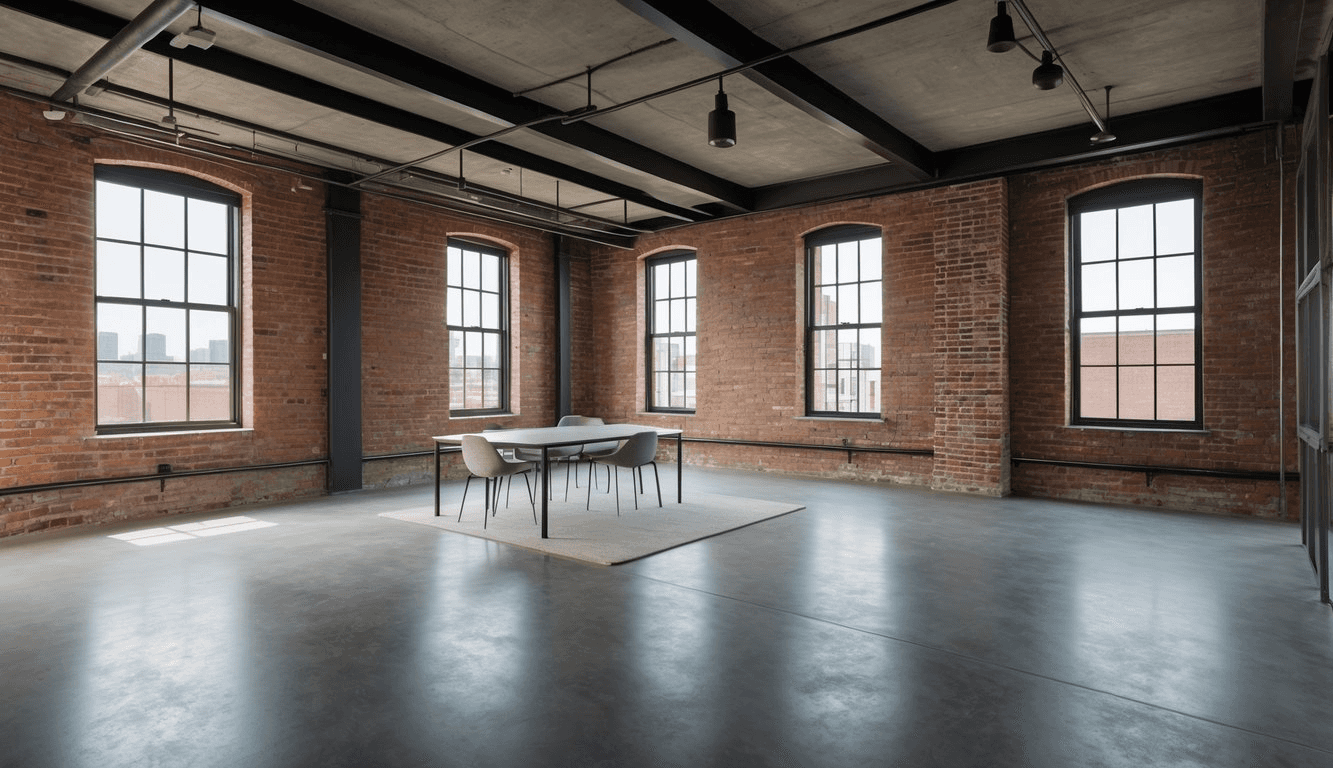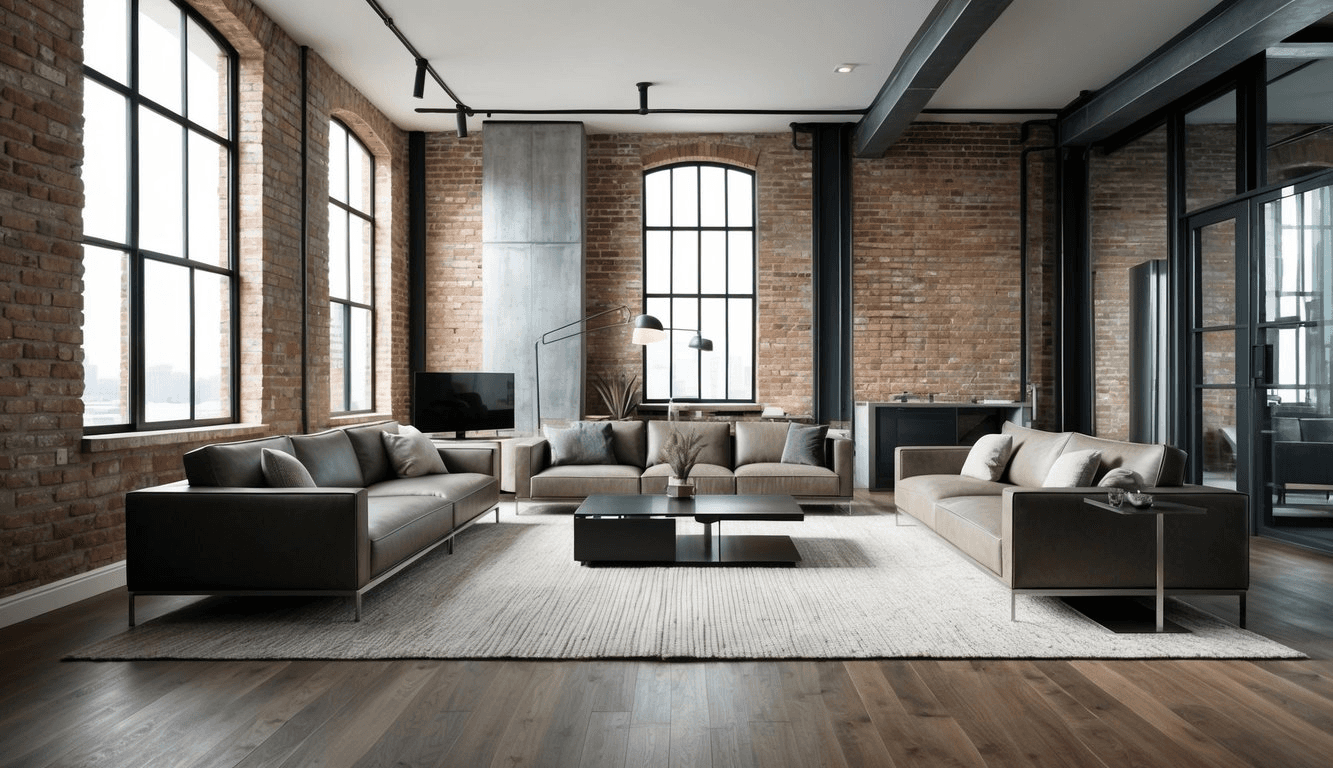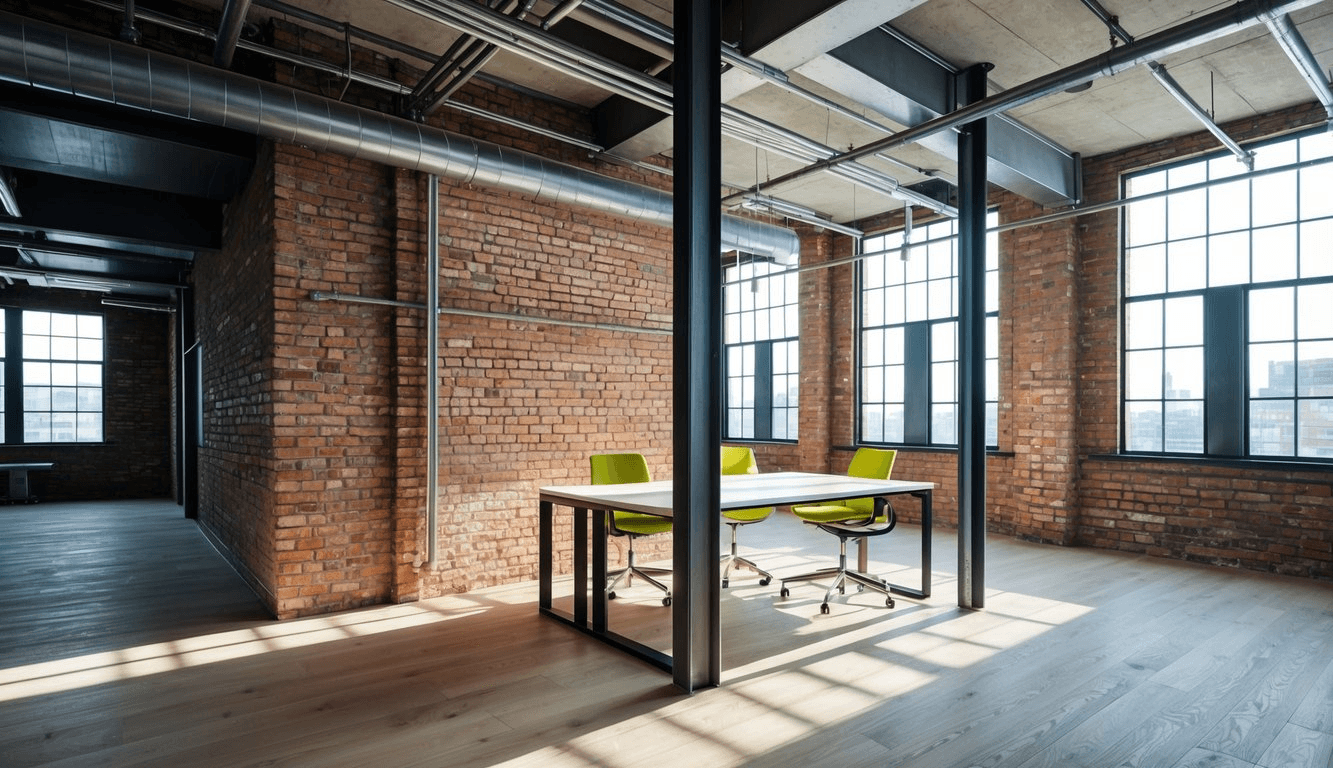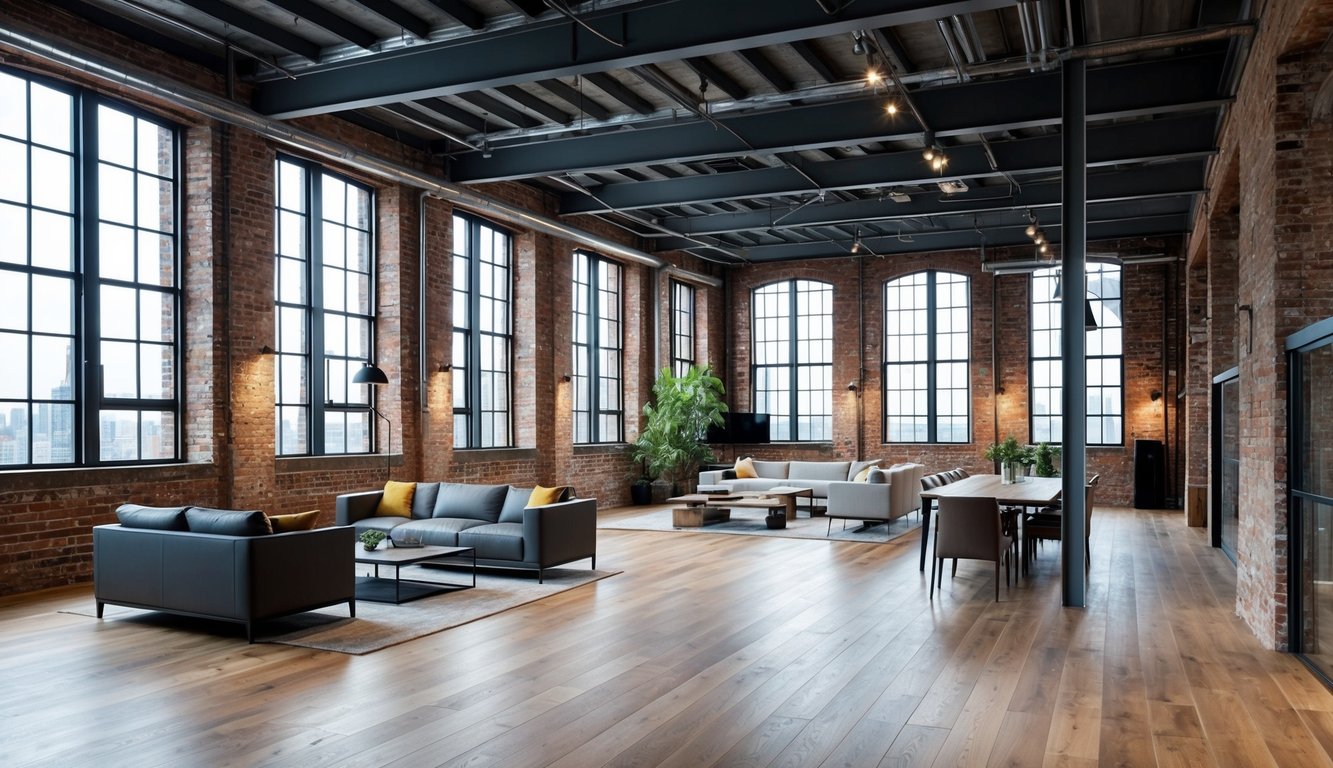Jan 14, 2025
•
Onton Team
Discover the essence of industrial interior design, where raw materials meet modern functionality. Transform your urban space with unique, minimalist aesthetics.
Industrial interior design combines raw aesthetics with modern functionality, creating spaces that are both edgy and inviting. This style emerged in the 1960s and 70s as artists and creatives began repurposing old warehouses and factories into living spaces.
Industrial design embraces exposed architectural elements like pipes, brick, and concrete. It also incorporates minimalist principles for a unique and captivating look.
The industrial style celebrates the beauty of unfinished surfaces and utilitarian objects. It often features a neutral color palette, open floor plans, and materials like metal, wood, and leather.
Large windows, high ceilings, and Edison bulbs are common elements that contribute to the spacious, airy feel of industrial interiors.
Incorporating industrial design into your home doesn't mean you need to live in a converted loft. You can add industrial touches to any space through carefully chosen furniture, lighting fixtures, and decor.
Mix sleek metal pieces with warm wood tones, or add vintage factory elements for an authentic industrial vibe.
Key Takeaways
Industrial design blends raw materials with minimalist aesthetics for a unique look
Open floor plans, exposed elements, and neutral colors define industrial interiors
You can incorporate industrial elements into any space through furniture and decor choices
What Is Modern Industrial Interior Design?
Modern industrial interior design blends raw urban elements with contemporary sophistication. It draws inspiration from factories and warehouses, incorporating exposed structures and materials.
You'll find exposed brick walls, metal accents, and open floor plans in this style. It embraces the authenticity of industrial spaces while adding comfort and functionality.
Key design elements include:
Concrete or wood floors
Exposed beams and ductwork
Large windows
Metal light fixtures
Vintage or repurposed furniture
The color palette typically features neutral tones like gray, black, and brown. Pops of color can be added through artwork or accessories.
Industrial design celebrates imperfections. Rough textures and worn finishes are prized for their character and authenticity.
To achieve this look in your home, focus on:
Mixing materials (wood, metal, glass)
Choosing minimalist furniture
Incorporating industrial-inspired lighting
Leaving structural elements exposed
This style works well in lofts, apartments, and converted spaces. It's adaptable to both residential and commercial settings.
Modern industrial design balances form and function. It creates spaces that are both stylish and practical, perfect for contemporary urban living.
History and Origins of Modern Industrial Design
Modern industrial interior design traces its roots to the Industrial Revolution of the 18th and 19th centuries. This era saw the rise of mass production and the construction of large factories and warehouses.
Initially, these industrial spaces were purely functional, designed for efficiency and practicality rather than aesthetics. The exposed brick walls, metal fixtures, and open floor plans were a necessity, not a style choice.
As cities grew, many old factories and warehouses fell into disuse. In the 1960s and 1970s, artists and creatives began to repurpose these spaces as living quarters. They appreciated the open layouts, high ceilings, and raw materials.
This trend gained momentum, leading to the birth of "loft living." You could find these converted spaces in urban areas, where old industrial buildings were transformed into trendy residences.
The aesthetic appeal of these industrial elements gradually seeped into mainstream interior design. Designers began incorporating industrial features into homes and commercial spaces intentionally.
Today, modern industrial design blends the raw, utilitarian aspects of industrial spaces with contemporary comforts. You'll often see exposed brick, metal accents, and open floor plans combined with plush furnishings and modern amenities.
Modern Industrial Influence on Interior Design
Industrial architecture has left an indelible mark on modern interior design. You'll find its influence in both residential and commercial projects across the globe.
Exposed brick walls and metal accents are hallmarks of this style. These raw elements bring an edgy, urban vibe to spaces.
Open floor plans are another key feature. They mimic the expansive layouts of factories and warehouses. This creates a sense of spaciousness and flow in your home or office.
Concrete floors and exposed ductwork add to the industrial aesthetic. They showcase the building's structural elements, turning them into design features.
Lighting plays a crucial role in modern industrial interiors. Pendant lights with metal shades or Edison bulbs are popular choices. They provide both illumination and industrial charm.
Furniture in this style often combines wood and metal. Think reclaimed wood tables with steel legs or leather sofas with exposed rivets.
Color palettes tend to be neutral, with shades of gray, brown, and black predominating. Pops of color can be introduced through artwork or accessories.
In commercial projects, you might see industrial elements used to create a hip, creative atmosphere. Tech startups and trendy cafes often embrace this aesthetic.
Remember, modern industrial design is adaptable. You can incorporate elements that suit your taste and needs while maintaining the overall industrial vibe.
Key Elements of Modern Industrial Interior Design
Modern industrial interior design blends raw, utilitarian elements with sleek, contemporary features. This style emphasizes authenticity, functionality, and a bold aesthetic that celebrates the beauty of industrial materials and structures.
Exposed Architectural Elements
Exposed brick walls, beams, and pipes are hallmarks of industrial design. These elements add character and visual interest to spaces. Leave ductwork and electrical conduits visible for an authentic industrial feel. Highlight steel beams and columns as architectural features.
High ceilings with exposed structures create an open, airy atmosphere. Showcase original wooden beams or steel trusses. If your space lacks these features, consider adding faux elements to achieve the look.
Material Authenticity
Use raw, unfinished materials throughout your space. Incorporate concrete floors, weathered wood, and metal accents. Choose furniture made from reclaimed wood or steel for an authentic industrial vibe.
Embrace rough textures and imperfections in surfaces. Leave brick walls unpainted to showcase their natural beauty. Use distressed leather and raw textiles for upholstery and soft furnishings.
Combine different materials like wood, metal, and stone to create visual interest and depth. Mix polished and matte finishes for contrast.
Open Space Planning
Adopt an open floor plan to maximize space and light. Remove unnecessary walls to create a loft-like feel. Use furniture and area rugs to define different zones within the open layout.
Large windows allow natural light to flood the space. If possible, install oversized industrial-style windows or skylights. This brightens the interior and connects it to the outside world.
Create flexible, multi-functional areas that can adapt to different needs. Use movable partitions or screens to divide spaces when needed.
Industrial-Inspired Lighting
Lighting plays a crucial role in industrial design. Choose fixtures that blend form and function. Pendant lights with metal shades, Edison bulbs, and adjustable task lamps are popular choices.
Incorporate a mix of lighting types. Use bare bulbs for ambient light and directional spotlights to highlight specific areas. Repurpose vintage industrial fixtures for a unique touch.
Don't be afraid to go big with lighting. Large, statement fixtures can serve as focal points in open spaces.
Raw-Refined Balance
Strike a balance between raw industrial elements and refined modern touches. Pair rough textures with smooth surfaces. Combine vintage pieces with contemporary furniture.
Soften industrial hard edges with organic shapes and natural materials. Add plants to bring life and color to the space. Use area rugs to define zones and add warmth underfoot.
Mix high-end finishes with more utilitarian materials. This contrast creates visual interest and prevents the space from feeling too cold or austere.
Neutral Color Foundation
Build your color palette on a foundation of neutral tones. Grays, whites, blacks, and browns dominate industrial interiors. These colors let the materials and textures shine.
Use pops of bold color sparingly to add visual interest. Red, yellow, or blue accents can enliven the neutral backdrop. Consider using colorful artwork or statement furniture pieces.
Incorporate different shades and tones within your neutral palette to add depth. Layer various textures to create visual interest without relying on color.
Functional Aesthetics
Choose furniture and decor that combine style with practicality. Look for pieces that serve multiple purposes or can be easily reconfigured. Storage solutions should be both functional and visually appealing.
Invest in quality, durable materials that can withstand daily use. Industrial spaces are meant to be lived in, not just admired. Select furniture with clean lines and minimal ornamentation.
Display utilitarian objects as decor. Vintage industrial equipment, tools, or signage can become unique art pieces. Embrace the "form follows function" principle in your design choices.
Substyles of Modern Industrial Interior Design

Modern industrial design encompasses several distinct substyles, each with unique characteristics and aesthetics. These variations allow you to customize the industrial look to your personal taste and space.
Rustic Industrial
Rustic industrial blends raw industrial elements with warm, natural materials. You'll find reclaimed wood beams, distressed leather furniture, and vintage metal accents. Exposed brick walls pair with wooden shelving units. Wrought iron light fixtures hang above farmhouse-style dining tables.
Color palettes lean towards earthy tones - browns, greens, and warm grays. Textiles like burlap and wool add softness. Adaptive reuse projects often showcase this style, preserving original architectural features.
To achieve this look, mix metal and wood finishes. Add vintage industrial pieces like old factory carts or metal lockers. Incorporate plants to soften the space and enhance the natural vibe.
Scandinavian Industrial
Scandinavian industrial merges the simplicity of Nordic design with industrial elements. You'll see a lighter, airier take on the industrial aesthetic. White walls and light wood tones create a bright backdrop.
Clean lines and minimalist furniture keep spaces uncluttered. Concrete floors or white-washed wood planks are common. Metal accents appear in lighting fixtures, chair frames, and decorative objects.
Black and white dominate the color scheme, with pops of muted pastels. Natural textiles like linen and sheepskin add texture. Large windows maximize natural light, a key feature of Scandinavian design.
Minimalist Industrial
Minimalist industrial strips the style down to its essentials. You'll find open floor plans with sparse furnishings. Every piece serves a purpose - form follows function.
Exposed structural elements take center stage. Concrete floors, metal beams, and ductwork remain visible. Furniture features simple, geometric shapes in materials like steel and leather.
Color palettes are often monochromatic - blacks, whites, and grays dominate. Pops of color are used sparingly for visual interest. Storage is built-in or concealed to maintain clean lines.
Eclectic Industrial
Eclectic industrial allows for more personalization and creativity. You can mix industrial elements with other design styles like mid-century modern or bohemian.
Vintage finds and unique art pieces add character. Bold colors and patterns break up the typical industrial palette. Mismatched furniture creates a collected-over-time feel.
Metal shelving units might display colorful pottery. A sleek modern sofa could sit next to an antique industrial cart coffee table. This style embraces contrast and unexpected combinations.
Luxe Industrial
Luxe industrial elevates the style with high-end materials and finishes. You'll see polished concrete floors instead of rough ones. Chrome and brass replace rusty metals.
Plush fabrics like velvet soften industrial furniture shapes. Crystal chandeliers hang from exposed beam ceilings. High-gloss cabinets contrast with matte black metal accents.
Color schemes often include rich jewel tones or metallics. Artwork tends to be large-scale and abstract. This style balances raw industrial elements with refined, luxurious touches.
Room by Room Modern Industrial Design Ideas

Modern industrial design adapts to various spaces in the home, blending raw materials with sleek elements. Each room offers unique opportunities to incorporate industrial aesthetics while maintaining functionality and comfort.
Living Room
Create an industrial living room by exposing brick walls or adding faux brick panels. Install metal shelving units for a functional yet stylish storage solution. Choose a leather sofa or sectional for a comfortable seating area that complements the industrial vibe.
Incorporate statement furniture pieces like a reclaimed wood coffee table or vintage metal chairs. Hang oversized industrial-style light fixtures to draw the eye upward and enhance the sense of space.
Add warmth with textured rugs and throw pillows in muted colors. Display artwork on metal easels or hang vintage factory signs for authentic industrial flair.
Kitchen
Transform your kitchen with stainless steel appliances and concrete countertops. Install open shelving using pipes and reclaimed wood for a rustic industrial look. Choose metal bar stools with wooden seats for your kitchen island.
Opt for pendant lights with metal shades to illuminate work areas. Use subway tiles for the backsplash, paired with dark grout for contrast. Incorporate a large farmhouse sink with an industrial-style faucet.
Display cookware on a hanging pot rack made from pipes and chains. Add character with vintage kitchen scales or an old factory clock on the wall.
Bedroom
Create a cozy industrial bedroom by using a metal bed frame as the centerpiece. Add warmth with wooden nightstands and soft, textured bedding in neutral tones.
Install a sliding barn door for closet access, adding both functionality and style.
Use exposed bulb wall sconces or adjustable arm lamps for bedside lighting. Incorporate storage with a vintage metal locker or trunk at the foot of the bed.
Hang a large mirror with a metal frame to reflect light and create the illusion of more space. Add personality with framed blueprints or vintage industrial patents as wall art.
Bathroom
Embrace industrial bathroom design with concrete floors and a metal vanity. Install a large mirror with a metal frame above the sink. Choose a rainfall showerhead and exposed pipe fixtures for an authentic industrial look.
Use subway tiles in the shower area, extending them to the ceiling for added impact. Add a ladder-style towel rack made from pipes for both storage and style.
Incorporate wood elements through a reclaimed wood shelving unit or a wooden bath mat. Display toiletries in glass jars with metal lids for a cohesive industrial aesthetic.
Home Office
Design an inspiring industrial home office with a metal desk as the focal point. Pair it with a comfortable leather office chair for long work sessions.
Install floating shelves using pipes and wood planks for storage and display.
Add task lighting with an adjustable desk lamp in black or metallic finishes. Use a pegboard wall organizer to keep tools and supplies easily accessible.
Incorporate vintage filing cabinets for storage and character. Display motivational posters in metal frames or hang a large world map for inspiration. Add a cozy area rug to soften the space and reduce noise.
Why Choose Modern Industrial Design
Modern industrial design offers a unique blend of style and functionality for your living spaces. This aesthetic embraces raw materials and utilitarian elements, creating an atmosphere that's both edgy and inviting.
One of the main draws is its versatility. You can easily adapt industrial design to suit various preferences, from minimalist to eclectic.
The style's flexibility allows you to incorporate personal touches while maintaining a cohesive look.
Durability is another key advantage. Industrial design often features sturdy materials like metal, concrete, and reclaimed wood. These elements not only look great but also stand up well to daily wear and tear.
The open concept layouts common in industrial design can make your space feel larger and more airy. High ceilings and expansive windows typical of this style further enhance this sense of openness.
Industrial design also embraces imperfections. Exposed brick walls, visible ductwork, and weathered finishes add character and depth to your interiors. This celebration of raw beauty creates a unique and authentic ambiance.
Cost-effectiveness is an often overlooked benefit. Many industrial design elements, like concrete floors or exposed beams, can be less expensive than their more refined counterparts.
By choosing modern industrial design, you're opting for a timeless aesthetic that balances form and function. It's a style that can grow with you, adapting to changing tastes and needs over time.
Get Started with Onton

Are you ready to bring your industrial interior design vision to life? Onton Imagine makes it easy to get started. This powerful AI tool puts professional design capabilities at your fingertips.
Begin by uploading a photo of your space. Make sure the image is well-lit and properly oriented for the best results. If you're starting from scratch, you can skip this step.
Next, describe your desired industrial style. Mention key elements like exposed pipes, metal fixtures, or dark woods. Be as specific as possible about the look you want to achieve.
Onton's AI will generate design ideas based on your input. Browse through the options and select your favorites. You can refine the results by adjusting your preferences or trying new prompts.
Once you've found a design you love, Onton Imagine Pro allows you to customize individual elements. Swap out furniture, change colors, or add unique touches to make the space truly yours.
To turn your virtual design into reality, Onton automatically suggests products that match your creation. This feature streamlines the process of bringing your industrial interior to life.
Remember, Onton is constantly updating with new features. Explore the tool regularly to discover fresh ways to enhance your industrial design projects.

